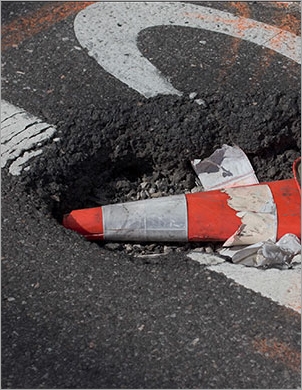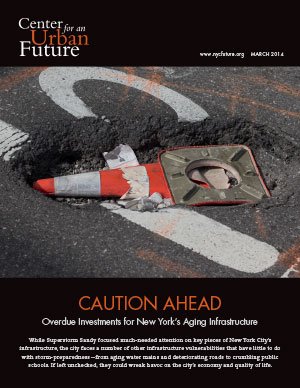Chairman Garodnick, Chairman Richards and Chairman Espinal, members of the joint committee, thank you for inviting me to testify.
My name is Adam Forman. I am the Research and Communications Associate at the Center for an Urban Future. The Center is a research institute devoted to growing and diversifying the New York City economy, expanding economic opportunity and alleviating obstacles facing low-income and working-class neighborhoods.
We recently published a comprehensive report highlighting the challenges New York City faces with its aging infrastructure. Titled Caution Ahead, our report identified numerous vulnerabilities within the city's utility and transportation infrastructure and building stock. The report was released one day before the tragic March 12th explosion in East Harlem.
The report’s findings were not surprising: New York City’s infrastructure is old. Over 170 school buildings and 165 bridges were constructed over a century ago. The city’s public hospital buildings are 57 years old, on average, and 531 public housing towers were built prior to 1950.
Gas, steam, water and sewage lines, unfortunately, are no exception. New York City’s 6,800 miles of water mains are 69 years old, on average. Over two-thirds are made of unlined cast iron or cement lined cast iron, materials susceptible to internal corrosion and prone to leak. 51 percent are narrower than 12 inches and, according to the Army Corp of Engineers, more likely to break than wider pipes.
To expedite the replacement of old and narrow water mains, Mayor Bloomberg’s 2007 PlaNYC report promised to replace an impressive 80 miles of mains every year. Since then, it has replaced only 27 miles per year. The city’s failure to achieve this replacement rate is regrettable. Neglecting this aging infrastructure will increase the frequency of water main breaks and leaks, leading to the corrosion of surrounding utility pipes, disrupting automobile, pedestrian and public transportation and stymieing local economic activity.
In 2013, for instance, there were 403 water main breaks across the city. Although most of these breaks are minor, serious ruptures are an annual occurrence. Earlier this month, a water main break at the intersection of East Houston and Ludlow flooded the streets, sidewalks and local businesses, including the iconic Katz’s Deli. In January, a major water main break on 13th Street in Manhattan flooded the street and nearby subways, halting train and car traffic for hours and flooding the basements of several nearby towers.
Leaking and ruptured water mains are responsible for a significant amount of waste. Citywide, the unaccounted-for-water rate—the difference between the amount of water that enters distribution mains and the amount that reaches customers—is a staggering 24 percent, double the 10-to-15 percent industry standard. Conditions are especially bad in the Bronx (32 percent unaccounted for), Brooklyn (31 percent) and Manhattan (23 percent).
The average age of New York City’s 6,400 miles of sewage mains is approximately 84 years. Nearly 4,000 miles of sewer pipe are made of vitreous clay. These older, earthenware pipes are more susceptible to cracking, blockage and groundwater infiltration.
Since the turn of the century, the number of sewer lines constructed or reconstructed has fallen. From Fiscal Year 2000 to 2006, the DEP installed an average of 42 miles of sewers per year. From Fiscal Year 2007 to 2013, the average fell to 17 miles.
Like many older cities, New York has a combined sewer system. During rainfall, excess flow is diverted to a combined sewer overflow (CSO) location and discharged, untreated, into the city’s waterways. Overflow occurs about half the time it rains, leading to an estimated 27 billion gallons of raw sewage and polluted stormwater pouring into the New York harbor every year.
To address this problem, DEP has launched an aggressive green infrastructure campaign, making the city more permeable to absorb rainwater before it enters the sewer system. The city plans to commit $2.4 billion in public and private investment over the next 18 years to increase these efforts.
Green infrastructure is a tremendous asset to the city. It simultaneously beautifies New York’s neighborhoods while alleviating severe gaps in the stormwater management system. However, city officials should consider investing in more traditional mitigation efforts as well, if they intend to dramatically reduce CSO discharges. An underground retention facility near the Paerdegat Basin, for instance, will reduce overflow discharges in the Jamaica Bay tributary by 70 percent—from 1.833 billion gallons to 555 million gallons per year. In comparison, the city’s 2,536 Greenstreet sites capture 105 million gallons of stormwater annually and its 100 bioswales retain 1,870 gallons apiece. The city would need to install nearly 700,000 bioswales to capture the equivalent rainwater of the Paerdegat facility.
Moving on to gas, Con Edison and National Grid each manage one of the oldest distribution networks in the country. Con Edison’s 2,234 miles of gas mains serve 833,000 customers in the Bronx, Manhattan and northern Queens. Their mains are 53 years old on average and 22 percent of their gas services - carrying gas from the mains to individual buildings - were installed prior to 1960. In 2012, their distribution system experienced nearly 3,300 leaks.
National Grid serves approximately 1.2 million customers in Staten Island, Brooklyn and southern Queens via 4,128 miles of gas main. The average main is 57 years old and 7 percent of their gas services were installed prior to 1960. In 2012, their distribution system experienced approximately 2,500 leaks.
In 2011, following a spate of deadly natural gas incidents, the Obama administration issued a Call to Action to “accelerate the repair, rehabilitation, and replacement of the highest-risk pipeline infrastructure”, singling out “pipelines constructed of cast or wrought iron and bare steel.” In New York City, 60 percent of Con Edison’s mains and 24 percent of its services are made of these leak prone materials. 48 percent of National Grid’s mains and 5 percent of its services are made of these same materials.
While gas explosions are mercifully rare in New York City, the environmental consequences of leaking gas pipes are significant. According to Bill McKibben, a prominent environmentalist, methane released from unburned natural gas is 20 to 100 times as potent a greenhouse gas as carbon dioxide. If more than 2 to 3 percent of gas escapes into the atmosphere from the point of extraction to its final destination, natural gas can do more damage to the climate than coal.
In New York City, 1.5 percent of National Grid’s gas is unaccounted for and 2.2 percent of gas entering Con Edison’s mains and service pipes—only the final stage in the extraction-transmission-distribution process—did not reach a final customer in 2012. Theft and inaccurate meter readings play a part, but so do leaks from old mains and services. National Grid and Con Edison’s line losses compare favorably to peer companies in Philadelphia (2.7 percent) and Boston (4.4 percent), but it is still cause for concern.
Today, it is more important than ever to address the city’s aging natural gas infrastructure. Natural gas accounts for approximately 65 percent of New York City’s heating needs and fuels 98 percent of in-city electricity generation. Gas usage is set to grow significantly in the coming decades, in large part due to significantly cheaper prices for natural gas and the recent citywide ban on #4 and #6 home heating oil. To accommodate the growing demand across the five boroughs, New York’s aging gas distribution system will need to be upgraded and expanded. Con Edison and National Grid have actively replaced their aging mains and services and should accelerate the replacement of cast iron and bare steel services and mains. While the state is responsible for regulating these utilities, the city can assist Con Edison and National Grid’s replacement efforts by better coordinating its work with the Department of Transportation and the DEP.
Rehabilitating New York City’s aging infrastructure is, of course, an expensive and long-term proposition. Our recent report, Caution Ahead, estimated that it would cost $47.3 billion over the next five year to bring the city (and its authority’s) transportation, utility and building infrastructure to a State of Good Repair. While this is daunting, the benefits of an expansive public works program are considerable. According to a 2009 University of Massachusetts study, every $1 billion invested in water infrastructure generates 12,000 new jobs. The same investment in fixing roads and bridges creates nearly 15,000 positions. Importantly, the repair and maintenance of existing infrastructure is found to generate more jobs than new construction.
To facilitate infrastructure rehabilitation in the coming years, the city should prioritize state of good repair investment over new projects. It should also encourage the Office of Management and Budget to improve its Asset Information Management System (AIMS) report, a condition assessment of city-owned buildings, parks, bridges and piers. The current inspections are cursory, poorly integrated into the capital planning process and do not include water and sewer assets, public housing, East River Bridges or agency vehicles.
To improve the water and sewage assets, specifically, we recommend two reforms. First, New York City should follow Seattle, Philadelphia, and 500 other cities, by replacing its sewer charges, currently assessed at 159 percent of the water rate, with a more nuanced stormwater management fee. Property owners would be charged according to the percentage of rainwater captured on their lot (before it enters the city’s overburdened sewer system). This would incentivize increased water retention on private property, with customers paying a lower fee as they introduce new green elements – trees, swales, porous pavement, and green roofs. This could be coupled with a credit program, repaid each month via the utility or property bill, to help customers finance the installation of green elements.
Second, the city should eliminate the “rental payment” it charges the New York City Water Authority. The fee no longer serves its original intent and, given the age and condition of New York’s water and sewer assets, the city should not be diverting money from these infrastructure systems to its general fund.
Thank you for considering my testimony. I look forward to your questions.
This testimony was presented on June 18, 2014.



